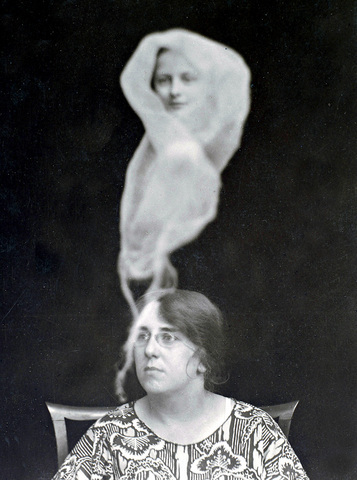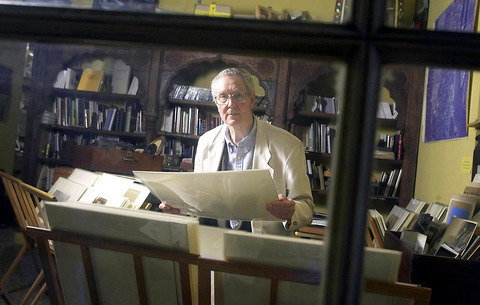It is not a place you would normally expect to find a curator preparing for a major photography show at the Metropolitan Museum of Art, in New York. But a few summers ago, Pierre Apraxine was camped out on the third floor of a rambling town house on West 73rd Street near Central Park, the headquarters of the American Society for Psychical Research, a 120-year-old repository of the paranormal whose founders included the philosopher William James.
In the world of photo collecting and scholarship, Apraxine is nothing less than an institution. For almost two decades, he served as the eyes, ears and auction proxy for the philanthropist Howard Gilman, who built a collection -- recently acquired by the Met -- that is widely considered to be one of the most important in the world.
On this particular day, however, Apraxine was working in the service not of photography but of the sixth sense. He had folded his lanky 1.89m frame into a small, steel soundproof booth illuminated by a red lamp. Halves of pingpong balls were taped over his eyes and headphones hissing white noise were placed over his ears. In a room nearby sat a fellow curator and friend, Sophie Schmit, who was given a randomly selected image on a piece of paper. The goal was for Apraxine, sealed in his chamber -- lulled into a deeply relaxed condition known as a ganzfeld state -- to receive the image that Schmit was sending. As it turned out, he performed fairly well, describing several images that corresponded to the ones Schmit was holding.

PHOTO: NY TIMES
When the positions were reversed, with Schmit in the chamber, the pair did even better -- Schmit described with sometimes eerie accuracy the image he was mentally willing her to see.
Apraxine grew up on a family estate in Estonia where supernatural goings on often seemed to be part of the natural course of the day. Does Apraxine, 70, really believe in things that go bump in the night? During lunch recently at the Met, Abraxine looked up from his plate and stared out into Central Park for a moment. "I have a formula, an answer for that that is ready-made," he said. "I believe you can see a ghost, but that doesn't mean I believe in ghosts."
He paused and elaborated. "I remain a noncommitted observer." But Apraxine has been a curious and open-minded observer almost all of his life, consulting psychics, undergoing hypnosis, reading books and magazines about the paranormal and, once, visiting a voodoo ceremony in Haiti. So his involvement in organizing the show at the Met -- The Perfect Medium: Photography and the Occult, a fascinating survey of the ways in which photography has been used to try to prove the existence of the supernatural -- is more than just a professional or aesthetic exercise for him. At the least, it is one of those coincidences Apraxine says he decidedly does not believe in.

PHOTO: NY TIMES
"There is nothing accidental -- at least in my life," he says. His early adult interest in occult photography grew out of his work as a collector, not a spiritual seeker, he said. In the early 1970s, when he began to work with Gilman to build a world-class photo collection, the strength of the Gilman holdings was in 20th-century work by photographers like Walker Evans and Robert Frank. Apraxine's mission was to start trolling backwards, buying good pictures from the 19th century, stretching all the way back to photography's infancy in the 1830s. To the surprise of both men, who had assumed that most of the best of 19th-century photography had already been bought by museums, masterpieces were still for sale around the world, and many were being sold for what now seem to be laughably small sums.
As the collection deepened, occult photographs were simply another important piece of the field's history. From the 1870s through the 1930s, the belief that cameras had the power to capture not just the visible and fleeting but also the invisible and ephemeral produced a huge body of images intended as almost scientific exhibits.
The 120 pictures in the exhibition are by turns spooky, beautiful, disturbing and hilarious. They are also, by and large, the visual records of decades of fraud, cons, flimflams and gullibility -- though there are also some pictures, like those produced by an eccentric Chicago bellhop, Ted Serios, said to be purely from his thoughts, in the 1960s, that have never been adequately explained.
"We don't consider it the real stuff, you know," said Dr Nancy Sondow, president of the American Society for Psychical Research, which lent several photographs to the show. Still, she added, "I guess it's interesting from the standpoint of the history of photography." The pictures are a window onto a bizarre, and almost-forgotten, period of American and European history, when the camps of spiritualism and strict rationality battled it out on the front pages of newspapers. Spirit photography began in a typically American burst of entrepreneurship, and for this reason serious European spiritualists were slow in joining. One wrote that while the US had taken the lead in many things, it had also "left us far behind in the invention of false rumors." But the practice soon took off in France and England.
By World War II interest had peaked, but the exhibition makes clear that it has never really gone away. The show includes some of the famous Polaroid images produced by Serios, who claimed to be able to project his thoughts onto film and whose work remains one of the best documented and most hotly debated cases in the field. Even today, fascination with the practice is widespread, aided by video technology and the Internet. Apraxine and Schmit, who organized the show with three other curators, stressed that the only way to do such a show was to profess official agnosticism.
"The authors' position is precisely that of having no position, or at least not in so Manichaean a form," they wrote in the exhibition's catalog.
But in a telephone interview from her home in Paris, Schmit conceded that a strong sense of "what if?" was also a basic requirement. "If I hadn't considered at least the possibility of it existing," she said, "I don't think I would have ever been interested in doing the exhibit."
That summer day at the American Society for Psychical Research, where the two curators were sorting through the group's archives to find photographs for the show, they agreed to participate in the telepathy experiment not as a joke but as a sort of curatorial research assignment for extra credit. "We are very open, both us, to that kind of thing," she said.
Indeed, for Apraxine, it seems to have been at times more than just openness.
Later in his life, in the 1960s, on the advice of acquaintances who worked at the occult magazine Planete in Paris, he went to see his first psychic, in the countryside near Orleans. "I wanted to see what my life would be like," he explained. He recalled being nervous and feeling a little silly. "I was expecting to see someone clothed in robes with an owl on his shoulder, you know?" he said. Instead the man was wearing shorts, and in his backyard among the clucking chickens, using a pendulum as an aid, he foretold for Apraxine "all the salient points of my life -- and they all happened."
Later, after moving to New York, he regularly consulted another psychic in the West Village.
At this point in his life, Apraxine said, he feels that many of his curiosities about otherworldly things have been satisfied, or have at least gone into hibernation for a while. He reads less about the occult and hasn't seen a psychic in years. Or, for that matter, a ghost. In many ways, he said, the Met exhibition did not develop as an outgrowth of his interests. It simply became another way of working through them, an exploration he hopes that people who see the show may want to take, too.
"I thought, `Maybe I will learn something by delving more deeply into this subject,"' he said.
The Perfect Medium: Photography and the Occult is at the Metropolitan Museum of Art Fifth Avenue and 82nd Street, Sept. 27 through Dec. 31.

On April 26, The Lancet published a letter from two doctors at Taichung-based China Medical University Hospital (CMUH) warning that “Taiwan’s Health Care System is on the Brink of Collapse.” The authors said that “Years of policy inaction and mismanagement of resources have led to the National Health Insurance system operating under unsustainable conditions.” The pushback was immediate. Errors in the paper were quickly identified and publicized, to discredit the authors (the hospital apologized). CNA reported that CMUH said the letter described Taiwan in 2021 as having 62 nurses per 10,000 people, when the correct number was 78 nurses per 10,000

As we live longer, our risk of cognitive impairment is increasing. How can we delay the onset of symptoms? Do we have to give up every indulgence or can small changes make a difference? We asked neurologists for tips on how to keep our brains healthy for life. TAKE CARE OF YOUR HEALTH “All of the sensible things that apply to bodily health apply to brain health,” says Suzanne O’Sullivan, a consultant in neurology at the National Hospital for Neurology and Neurosurgery in London, and the author of The Age of Diagnosis. “When you’re 20, you can get away with absolute

May 5 to May 11 What started out as friction between Taiwanese students at Taichung First High School and a Japanese head cook escalated dramatically over the first two weeks of May 1927. It began on April 30 when the cook’s wife knew that lotus starch used in that night’s dinner had rat feces in it, but failed to inform staff until the meal was already prepared. The students believed that her silence was intentional, and filed a complaint. The school’s Japanese administrators sided with the cook’s family, dismissing the students as troublemakers and clamping down on their freedoms — with

As Donald Trump’s executive order in March led to the shuttering of Voice of America (VOA) — the global broadcaster whose roots date back to the fight against Nazi propaganda — he quickly attracted support from figures not used to aligning themselves with any US administration. Trump had ordered the US Agency for Global Media, the federal agency that funds VOA and other groups promoting independent journalism overseas, to be “eliminated to the maximum extent consistent with applicable law.” The decision suddenly halted programming in 49 languages to more than 425 million people. In Moscow, Margarita Simonyan, the hardline editor-in-chief of the